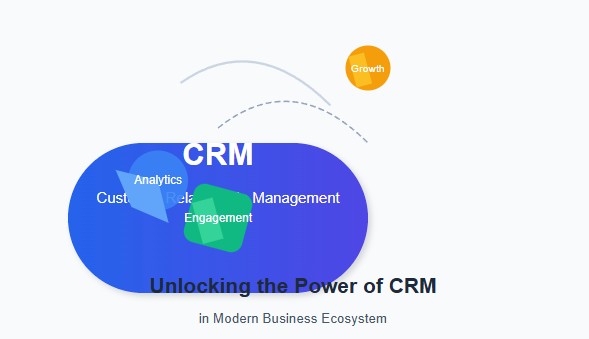In today’s ultra-connected digital economy, one acronym has become central to business strategy across industries and continents: CRM. Standing for Customer Relationship Management, CRM is more than just software—it’s a philosophy, a strategy, and a powerful technology solution wrapped into one. But what does this business acronym truly signify in modern enterprise operations, and why should every entrepreneur, marketer, and sales executive care?
This comprehensive guide will decode the CRM business acronym, explore its components, historical evolution, types, business benefits, and practical examples. By the end, you’ll have a fresh, unique take on why CRM isn’t just a buzzword but the backbone of sustainable customer-centric success.
Table of Contents
🔍 What is CRM? Breaking Down the Acronym
CRM = Customer Relationship Management
Each word in this acronym carries strategic weight:
-
Customer: The lifeblood of any business. Without customers, there is no revenue.
-
Relationship: The emotional and transactional bond businesses strive to build and nurture.
-
Management: The strategic oversight and technology involved in organizing, automating, and synchronizing interactions.
So, CRM is both a system and strategy used to manage a company’s interactions with current and potential customers. It uses data analysis to study customer history, improve business relationships, enhance customer retention, and ultimately drive sales growth.
🧭 The Evolution of CRM: From Rolodex to Cloud-Based AI
The concept of managing customer data isn’t new. Here’s a brief historical timeline showing the evolution of CRM systems:
📇 1980s: The Paper Age
-
Sales professionals kept notes in rolodexes, spreadsheets, and personal notebooks.
-
CRM was manual and heavily dependent on individual relationships.
💽 1990s: The Digital Dawn
-
Businesses adopted database marketing and contact management software like ACT! and GoldMine.
-
Siebel Systems introduced one of the first enterprise CRM platforms.
☁️ 2000s: The Cloud Revolution
-
Salesforce.com pioneered the SaaS CRM model (CRM-as-a-Service).
-
CRM became accessible to SMEs, not just large corporations.
🤖 2010s-Present: AI-Powered CRM
-
CRMs now integrate AI, machine learning, predictive analytics, and omnichannel support.
-
Platforms like HubSpot, Zoho, and Microsoft Dynamics 365 combine sales, marketing, and customer service in one ecosystem.
🧱 Core Components of CRM Systems
A good CRM system comprises several interconnected modules. Let’s break them down:
1. Sales Force Automation (SFA)
-
Tracks customer interactions, manages pipelines, and forecasts revenue.
-
Automates repetitive tasks like sending emails, scheduling calls, and updating records.
2. Marketing Automation
-
Segments customers, automates campaigns, and analyzes performance.
-
Integrates with tools like email platforms and social media dashboards.
3. Customer Service Management
-
Offers a ticketing system, live chat, chatbot integration, and feedback loops.
-
Supports omnichannel service via email, phone, social media, and web portals.
4. Analytics & Reporting
-
Generates real-time dashboards.
-
Uses AI to predict churn, buying behavior, and campaign success.
5. Mobile CRM
-
Enables on-the-go access to customer data.
-
Improves field sales and remote work capabilities.
🏭 Types of CRM Software: Strategic vs Operational vs Analytical
There are three main types of CRM systems. Each serves different business needs:
🧠 Strategic CRM
-
Focuses on customer-centric business culture.
-
Builds long-term customer engagement and loyalty.
⚙️ Operational CRM
-
Automates sales, marketing, and service processes.
-
Example: Salesforce, Zoho CRM.
📊 Analytical CRM
-
Gathers and analyzes customer data for insights.
-
Used by marketing teams for trend analysis and decision-making.
🚀 Why CRM is a Game-Changer for Businesses
Implementing CRM isn’t just a technical upgrade—it’s a business transformation strategy. Here’s why:
1. Enhanced Customer Satisfaction
-
Provides 360° view of customers.
-
Ensures faster response time, personalized service, and consistent experience.
2. Increased Sales
-
Boosts productivity with automated follow-ups and lead scoring.
-
Converts more leads with better targeting.
3. Improved Data Management
-
Centralizes customer data in one location.
-
Reduces data silos across departments.
4. Streamlined Team Collaboration
-
Shared access to updated customer profiles.
-
Smooth handoffs between sales, marketing, and support teams.
5. Scalability
-
Grows with your business. Start with basic features, expand as needed.
-
Cloud-based CRMs like HubSpot offer modular upgrades.
🧪 Real-World Examples of CRM in Action
Here are a few use cases that illustrate the power of CRM:
✈️ Airline Industry – Emirates
-
Uses CRM for customer loyalty tracking, upgrades, and special offers based on travel patterns.
🛍️ Retail – Amazon
-
Tracks purchases, recommends products, and personalizes content using CRM-driven algorithms.
📚 Education – Universities
-
Manages prospective student information, communication, and application status.
🏥 Healthcare – Clinics
-
Stores patient history, schedules appointments, and automates reminders securely.
🧰 Choosing the Right CRM Platform
Choosing a CRM depends on your company’s size, budget, and goals. Popular platforms include:
| CRM Platform | Best For | Pricing (approx.) |
|---|---|---|
| Salesforce | Enterprise-level customization | $$$ (Premium) |
| HubSpot | Startups and SMBs | Free to $$$ |
| Zoho CRM | Budget-friendly and flexible | $$ |
| Pipedrive | Sales-focused small businesses | $$ |
| Microsoft Dynamics | Enterprise + Office 365 integration | $$$ |
🔒 CRM & Data Privacy
With great data comes great responsibility. CRM systems must comply with:
-
GDPR (Europe)
-
CCPA (California)
-
HIPAA (Healthcare)
Ensure your CRM:
-
Has encryption.
-
Offers access control.
-
Provides audit logs.
-
Respects user consent.
📈 Future of CRM: Where It’s Headed
The CRM of the future is smarter, more predictive, and even more personal. Trends to watch:
-
AI & ChatGPT-powered assistants
-
Voice-activated CRM commands
-
Blockchain-secured customer data
-
Augmented Reality in customer interaction
-
Emotion AI for mood-based service delivery
🧠 Final Thoughts: CRM Is More Than Just an Acronym
CRM, as a business acronym, may look simple—but it encapsulates an entire ecosystem of customer-focused growth. From startups managing their first 100 leads to Fortune 500 companies scaling global operations, CRM is a non-negotiable tool for thriving in the modern marketplace.
🔁 Whether you’re just starting your CRM journey or looking to optimize your current setup, remember: it’s not just about technology—it’s about building better relationships.




